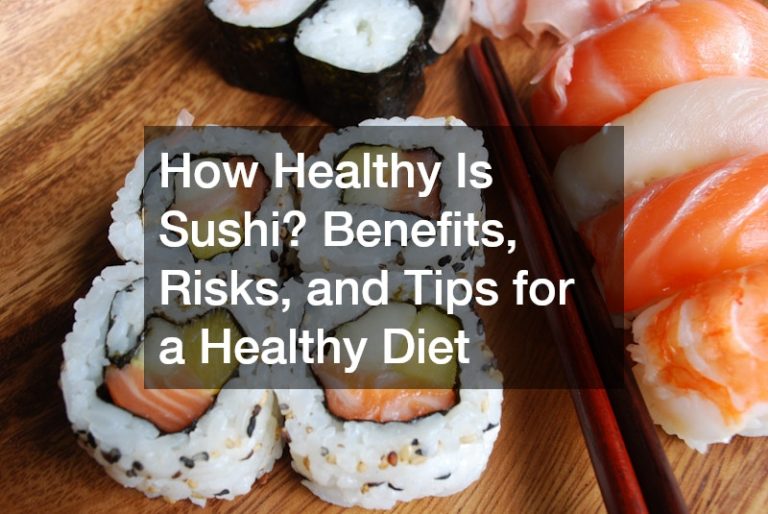

Sashimi, the Japanese delicacy of thinly sliced raw fish, has grown in popularity worldwide. Many people wonder whether it’s a healthy choice or just an indulgence. When enjoyed in moderation and chosen wisely, sashimi can be a nutrient-rich, low-calorie option that supports a balanced diet. This article explores the health benefits, potential risks, and tips for incorporating sashimi into your meals.
Nutritional Benefits of Sashimi

Sashimi is not only delicious but also offers several key nutrients that contribute to overall health. Its simplicity allows the natural flavors and nutrients of the fish to shine.
- High-Quality Protein: Raw fish is an excellent source of lean protein. Protein supports muscle repair, keeps you full longer, and helps maintain metabolic function.
- Omega-3 Fatty Acids: Fish such as salmon, mackerel, and tuna are rich in omega-3 fatty acids. These healthy fats can reduce inflammation, lower triglycerides, and support heart and brain health.
- Vitamins and Minerals: Sashimi provides essential nutrients such as vitamin D, vitamin B12, selenium, and iodine, which are important for immune function, thyroid health, and energy production.
- Low in Calories: Without the added rice or sauces found in sushi rolls, sashimi is low in calories, making it suitable for weight-conscious diets.
By choosing a variety of fish types, you can maximize nutrient diversity while minimizing potential exposure to mercury.
How Sashimi Supports Heart Health
Regularly including fish in your diet has been linked to improved cardiovascular health. Sashimi, being high in omega-3 fatty acids, offers several benefits for your heart.
- Helps lower blood pressure and reduces the risk of heart disease.
- Reduces triglycerides, a type of fat in the blood that contributes to plaque buildup.
- Promotes healthy cholesterol levels, balancing LDL (“bad”) and HDL (“good”) cholesterol.
For individuals aiming to improve heart health, sashimi can be a convenient, tasty addition to a balanced meal plan.
Digestive Benefits and Weight Management
Sashimi is easy to digest and can fit into a weight management plan. Its high protein content helps you feel full while contributing minimal calories.
- Supports satiety and reduces the likelihood of overeating.
- Pairs well with fiber-rich sides such as seaweed salad or steamed vegetables.
- Helps maintain stable blood sugar levels when eaten with a balanced meal.
Sashimi also avoids heavy sauces or fried ingredients that are commonly found in other types of sushi, making it a lighter alternative.
Potential Risks of Eating Sashimi
While sashimi offers many benefits, there are some risks to be aware of, especially for vulnerable populations.
- Mercury Exposure: Certain fish, such as tuna and swordfish, can contain higher levels of mercury. Limit consumption to once or twice per week for these species.
- Foodborne Illness: Raw fish may carry bacteria or parasites. Choosing reputable restaurants or trusted suppliers is critical to reduce the risk.
- Allergic Reactions: Some people may be allergic to certain fish or shellfish used in sashimi. Symptoms can range from mild to severe.
- Sodium Considerations: While sashimi itself is low in sodium, dipping sauces like soy sauce can contribute to high sodium intake, affecting blood pressure.
Pregnant women, older adults, and immunocompromised individuals should be especially cautious when consuming raw fish.
Best Sashimi Choices for Health

Making mindful choices can maximize health benefits while reducing risks.
- Opt for low-mercury fish such as salmon, trout, and tilapia.
- Include vegetables like radish or cucumber as garnish for fiber and vitamins.
- Pair with low-sodium soy sauce or skip sauces altogether to control sodium intake.
- Rotate different fish types to diversify nutrients and limit exposure to toxins.
Combining sashimi with wholesome sides, like miso soup or seaweed salad, makes for a satisfying and nutrient-rich meal.
How Sashimi Fits Into a Balanced Diet
Sashimi can be incorporated into a healthy diet alongside other protein sources and whole foods.
- Pair with salads or steamed vegetables to boost fiber intake.
- Use green tea or fruit as a low-calorie beverage option to complement your meal.
- Rotate sashimi with other lean proteins such as tofu, eggs, or chicken for dietary variety.
- Practice portion control to avoid overeating, especially when consuming higher-fat fish like mackerel or salmon.
When balanced with nutrient-dense sides, sashimi offers a flavorful, protein-rich meal option that supports overall wellness.
Sashimi vs. Sushi
Many people confuse sashimi and sushi. While sashimi is purely raw fish, sushi typically includes rice, vegetables, and sometimes fried ingredients.
- Calories: Sashimi is lower in calories compared to many sushi rolls.
- Sugar and Carbs: Sushi rice contains sugar and carbs, which may impact blood sugar.
- Fat Content: Sushi rolls with mayonnaise, tempura, or fried ingredients contain added fat and calories.
For those wondering if sushi is healthy, sashimi is a leaner, nutrient-rich option that can fit into most balanced diets. Pair it with vegetables, moderate sauces, and diverse protein sources for maximum benefits. Always prioritize fresh, high-quality fish from reputable sources to enjoy sashimi safely.
Tips for Enjoying Sashimi Safely
Following safety guidelines ensures that sashimi remains a healthy choice.
- Buy from trusted restaurants or suppliers with high hygiene standards.
- Check fish freshness: Look for clear eyes, firm flesh, and no strong odor.
- Consume promptly: Raw fish should be eaten shortly after preparation to minimize bacterial growth.
- Store correctly: Refrigerate at proper temperatures if not consumed immediately.
By following these guidelines, you can enjoy sashimi with minimal risk while maximizing its nutritional benefits.
Frequently Asked Questions
Does eating sashimi make you sick?
If sourced and stored correctly, the risk is low. Always choose reputable sources and avoid fish with high mercury content.
Can sashimi help with weight loss?
Yes, because it is high in protein, low in calories, and easy to pair with fiber-rich sides.
Is sashimi safe during pregnancy?
Pregnant women should avoid raw fish due to increased risk of foodborne illness and mercury exposure.
How often can I eat sashimi?
Moderation is key. Limiting higher-mercury fish to once per week while rotating other varieties is recommended.
Does sashimi provide all necessary nutrients?
While rich in protein, omega-3s, and vitamins, it should be paired with vegetables, fruits, and other protein sources for a balanced diet.
Conclusion
Sashimi can be a healthy addition to a balanced diet when consumed wisely. Its high-quality protein, omega-3 fatty acids, and essential vitamins support heart health, weight management, and overall wellness. Being mindful of potential risks such as mercury exposure and foodborne illness is essential, particularly for vulnerable populations. Pairing sashimi with vegetables, low-sodium condiments, and other nutrient-rich foods ensures a complete and satisfying meal. If you enjoy sashimi regularly, you can also rotate it with other protein sources and whole foods to maintain dietary variety.
Whether you’re a sushi lover or new to Japanese cuisine, sashimi provides a flavorful and nutrient-rich option that aligns with healthy eating habits.
